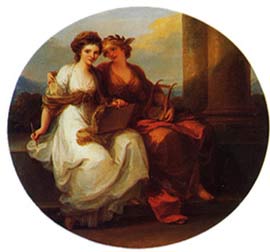Ellen and Jim Have a Blog, Too
We are two part-time academics. Ellen teaches in the English department and Jim in the IT program at George Mason University.


Angelica Kauffmann: artefacts of her spirit in many forms in lovely places · 15 February 06
My dear Anne,
Materials keep pouring in. And so I’m able to write you a third letter about Angelica Kauffmann. The first time I wrote to you about her life as told by Germaine Greer and had several beautiful images of her best paintings in the allegorical, realistic, and classical mode to send on; the second time I had an autograph letter, could qualify Ms Greer’s comments with information from a review of books on Miss Kauffmann’s life, art, and projected image (to protect her from denigrating slanders), and sent on more pictures, one a popular one from the period from Sterne’s Sentimental Journey and the other the effective almost photographic painting of the Duchess of Devonshire.
Now, thanks to Fran, we have Miss Kauffmann as an artist in industrial design: pottery, china, furniture medaillons, snuff-boxes, tea caddies, decorator of ceilings, walls, and jars. Again, though, I cannot fit the images into this letter. one image into the letter itself, a slightly blurred image of pottery. owever, all you need do (once again) is click here to reach some Wedgewood pottery, here for a gorgeous picture of her designs for Wedgewood China and here for two very feminine Wedgewood jars.
The colors repeat the feminine shapes, and the scenes too are more l’écriture-femme: idyllic Arcadian in genre. But have a closer look. We see two women playing with, amusing a nude baby in one; in the other, a group of nymphs listening to a male playing on the lyre.
Fran also found a painting in which Kauffmann placed herself (on the left):
The Artist in the Character of Design Listening to the Inspiration of Poetry (1782)
It’s at Kenwood House, London. Miss Kauffmann did much wrok for the Adams brothers, and Fran told me that Kauffman was mentioned as part of the Valentine Day celebrations at Kenwood House today: her relationship with Antonio Zucchi is supposed to have been cemented there, as he was painting the Robert Adam library ceiling at the same time as she was doing her own paintings for the building. Angela remarked that Miss Kauffman painted the ceilings of some of the houses (all private so not viewable) about Bedford Square, London (the architecture overseen by the widow of the 4th Duke of Bedford) and also used Coade stone (a fake marble concrete created by a woman sculptor) for some of the decorations on the buildings.
Good news, Anne. Beyond reading Madame d’Arblay’s Evelina, we are on Eighteenth Century Worlds now also planning eventually (say two books from now) to read the Memoirs of Madame Vigée LeBrun, translated by Lionel Strachey, and introduced by John Russell (no less). The lives of these two successful women painters have some uncanny parallels: both workaholics, both married con men the first time; both projected a conventional image to protect themselves: instead of playing virgin princess, Madame Vigée-LeBrun painted herself as an iconic devoted mother to her daughter. Both travelled to the continent, both made a lot of money and left much art.
We have other hopes: to read Sarah Fielding, more Charlotte Smith, perhaps Amelie Opie’s Adeline Mowbray. And 9 people have "signed" on at Eighteenth Century Worlds.
Ah, Anne, you must read with us. I know with travelling about on ships with my brother, you can’t join our community at ECW, but as he said at the dinner so long ago now, a ship is not a crude place where no civilized life can take place. You have your closet and library area. Take the books with you and I’ll write to you telling you some of what we say.
Much cheered,
Sophia
--
Posted by: Ellen
* * *
Comment
commenting closed for this article

